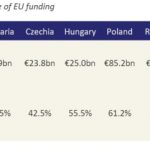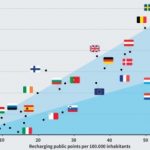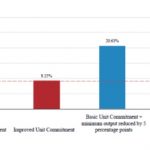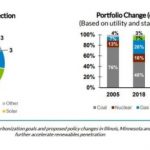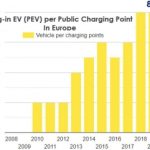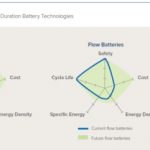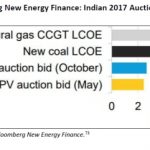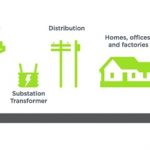Six Central and East European nations, heavily dependent on coal, have been very cautious about the pace of the EU’s transition. For them - Bulgaria, Czechia, Hungary, Poland, Romania and Slovakia - the political and economic disruption looks far harder to bear. E3G has just released a report that suggests this picture can change. The report’s authors – Felix Heilmann, Rebekka Popp and Ada Ámon – explain that coal is becoming less profitable, … [Read more...]
Modelling total costs for Onshore Wind power plants: from site prep to grid connection
The costs of wind turbines is dropping. But that means all the other capital costs - site preparation, foundations, infrastructure, tower construction – will become a bigger part of the total. In the U.S. they currently account for around 30% of the capital expenditures needed to install a land-based wind plant. To keep those costs under control the National Renewable Energy Laboratory (NREL) has created a comprehensive open-source modelling … [Read more...]
EU pathway to 3m EV charge points by 2030
Right now the EU has around 185,000 public charge points, which is enough for today’s market (seven cars for each point). The current policy scenario targets 33m electric cars by 2030 (44m for climate neutrality). Transport & Environment’s Nico Muzi summarises their latest report that plots their ambitious pathway. It’s driven by the forceful idea of a European ‘right to plug’, and enabled by their new Public Charging Supply metric, using a … [Read more...]
Peak Energy by 2030: Efficiency gains will make the Transition affordable
We can’t afford the energy transition? Next time you hear that from someone, perhaps you can show them this. Sverre Alvik at DNV GL explains that, according to their latest Energy Transition Outlook, although annual global energy expenditure will have to increase from $4.6tn in 2017 to $5.5tn in 2050, its share of growing world GDP will almost halve from 3.6% to 1.9%. That’s because continuing energy efficiency gains are making sure that total … [Read more...]
Distributed Solar: rooftop residential, commercial systems keep getting cheaper
In the U.S., PV module efficiency (median values) rose from 12.7% in 2002 to 18.4% in 2018, much of it in the last decade and a full percentage-point increase in the last year alone. The best modules are even more efficient, says John Rogers at the Union of Concerned Scientists. Improvements have come from manufacturing processes and cell architectures, and the increasing share of more-efficient mono-crystalline technologies: up from 40% in 2016 … [Read more...]
Grid-Interactive Buildings solutions: U.S. govt is looking for you
According to U.S. figures, up to 80% of peak electricity demand comes from buildings. So designing them to be energy efficient, with their own generation (e.g. rooftop solar), storage, and load-flexibility – and making it a cost effective industry standard – would be a game changer. It’ll make the grid more resilient, and take pressure off utilities investing in expanding the underlying infrastructure. Sneha Ayyagari and Matt Jungclaus at Rocky … [Read more...]
Better grid integration beats coal plant ramping to reduce wind, solar curtailment
Wind and solar curtailment is worst where these renewables are poorly integrated into the grid. The further their energy can reach the more regions they can service, thus minimising curtailment. If they don’t reach far, local coal plants must ramp down - but only if they’ve been retrofitted to be able to do so. It’s a problem faced by many countries: spend money on the retrofits or the integration? Writing for the Regulatory Assistance Project … [Read more...]
Grid switchgear uses SF6, the world’s most potent greenhouse gas. How do we regulate it?
Sulphur Hexafluoride (SF6) is described as the world’s worst greenhouse gas. It’s 23,500 times more potent than CO2. Global annual emissions are 8,100 tonnes, equivalent to the CO2 emissions of 100m cars. It has an atmospheric lifetime of over 1,000 years and its installed base is expected to grow by 75% by 2030. 80% of all SF6 is used in gas insulated switchgear, a vital component of the grid (isolating and protecting different sections), so … [Read more...]
California fires and blackouts: would non-profit utilities be more reliable, safer, cheaper?
The wildfires in California ignited by poorly maintained transmission lines have themselves ignited a debate about whether the guilty - and now bankrupt - energy utility PG&E (the largest in the state) should now become publicly owned. That in turn has led Severin Borenstein at the Energy Institute at Haas to consider the pros and cons of public v private in this vital activity. The first thing to note is that electricity transmission and … [Read more...]
Midwest U.S. grid operator MISO: modelling for a clean energy future
Planning can’t be easy for a grid operator. Take MISO which operates one of the world’s largest energy markets. They’re responsible for integration and bulk transmission across the central U.S., but decisions on the actual future energy mix and demand are being made elsewhere: by state governments, utilities and consumers big and small. Given the amounts invested in infrastructure and the lead times involved, no one will thank MISO if their … [Read more...]
Electro-mobility planning, pricing, smart-charging: “Pentalateral Region” can lead Europe
At the end of October, Ministers and Director-Generals of Energy and Mobility from the Pentalateral Region (Belgium, the Netherlands, Luxembourg, France and Germany), CEOs and experts came together to understand how electro-mobility can accelerate the energy transition. Reducing vehicle emissions is one thing, but a vast number of “batteries on wheels” can also enable rapid grid expansion. IRENA were one of the experts, and their analysis says … [Read more...]
The 7 battery technologies that can be cost competitive by 2030 for EVs to grids
Rapid performance improvements, falling prices and massive investment is accelerating us towards a time when batteries undercut fossil fuels for storage and despatch, right across the board, according to a report by Rocky Mountain Institute. The authors, Charlie Bloch, James Newcomb, Samhita Shiledar and Madeline Tyson have made forecasts for 7 battery technologies: the current leader Li-ion as well as Li-Metal, Li-Sulphur, Zinc, High … [Read more...]
Creating a market to trade excess wind/solar between states (without outsourcing your emissions!)
How do you get neighbouring states, with different renewables mixes, and different emissions targets and penalties, to trade their surplus energy? It’s one of the biggest challenges to face the rapid growth of intermittent wind and solar. Meredith Fowlie at the Energy Institute at Haas describes how an “Energy Imbalance Market” (EIM) is operating across eight states in the west of the U.S. Bidding for your neighbour’s excess renewable energy is … [Read more...]
India: coal plummets, renewables stepping in
In 2018, 80% of India’s total energy lending went to renewables. Coal got the rest, a major fall compared to 2017. No wonder, given coal plants have been running at below 60% utilisation for two years with the operators suffering huge losses. Renewables are now undercutting coal and getting cheaper. And shortages in water – needed for plant cooling – just add to their woes. Vibhuti Garg at IEEFA catalogues the problems, then describes the … [Read more...]
Non-Wires Alternatives for grid expansion: what the U.S. can teach Europe
Grid expansion usually means more power stations and wires. Far from simple, and very expensive. Non-Wires Alternatives (NWA) solve the problem differently by reducing net demand. Modern methods of energy efficiency, demand response, storage, and distributed generation are coordinated and used instead, under the banner of Distributed Energy Resources (DER). Crucially, it can cast utility firms in the role of market makers, not just generators and … [Read more...]


